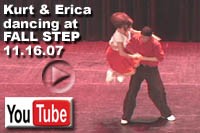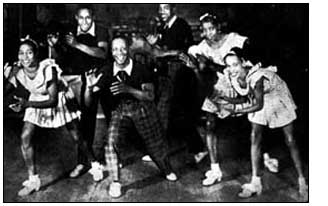Photo: "Shorty" George Snowden, (center) with
other Savoy performers, mid-'30s
(Jazz Dance by Jean & Marshall Stearns, DaCapo Press, 1994 - recommended)
Want to see a cool breakaway improv?
YES!

 At first, the dance
was called LINDY or LINDY HOP. By the late '30s, the name JITTERBUG prevailed
throughout most of the world, although styles abounded. In New York City, however,
many used LINDY HOP to refer to all manner of variants, barely recognisable from
the original, all through the '50s, and to this very day. The '90s Lindy Hop revival
has reverted to the use of LINDY HOP for the ultra-performance style of Savoy
stars Whitey's Lindy Hoppers.
At first, the dance
was called LINDY or LINDY HOP. By the late '30s, the name JITTERBUG prevailed
throughout most of the world, although styles abounded. In New York City, however,
many used LINDY HOP to refer to all manner of variants, barely recognisable from
the original, all through the '50s, and to this very day. The '90s Lindy Hop revival
has reverted to the use of LINDY HOP for the ultra-performance style of Savoy
stars Whitey's Lindy Hoppers.
Where did Lindy Hop come from? A blending of African solo movement for personal expression and European folk/courtly social dance, swing dance has remote plantation roots. The marraige at first took place on the Afro-American side, often as a mockery of European partner dancing. As Afro partnering styles developed, they became much more sexually suggestive than even the most torrid of Anglo social dances, the (gasp!) Waltz.
The dance incorporated the pre-swing Texas Tommy, Hop, Charleston, and an abundant repertoire of funny animal and pelvic-based moves later termed jazz moves. (Many ballrooms, including the Savoy, banned the Charleston for years, it's rather "kicky" style endangering nearby dancers. (And it's just as dangerous in the '90s, by the way! Been kicked yet?) Early Lindy Hop was a combination of these dances, re-named. The famous story of the re-naming bears yet another re-telling.
On July 4, 1928, the 18th (!) day of a dance marathon at the Marathon Casino, the NYC Board Of Health finally closed down the event. Four of the original 80 couples were left standing. Savoy star "Shorty" George Snowden (number "7") and his partner shared the prize with the other three couples.
Earlier, with the event in full swing, people could post a small cash prize with the MC for a brief mini-contest among the survivors. This was the backdrop for Shorty's spontaneous throw-out breakaway and flash footwork improv, capturing media attention. "What are you doing with your feet?" asked the Fox Movie Tone News interviewer. "The Lindy (Hop?)," replied Shorty. (Charles A. Lindbergh had recently "hopped" the Atlantic: over 1-1/2 years prior, landing on May 21, 1927.) End of famous story.
Sort of. But did Shorty answer the actual question? The interviewer queried about footwork, but Shorty applied the term LINDY to the breakaway and improv idea. Interviewed decades later, Shorty didn't remember exactly what footwork he did, except that it was fancy. Instead, he focused on the breakaway and improv idea as LINDY HOP. Since this was already part of the Texas Tommy, with at least a 15 year pre-history, Shorty didn't invent it. He merely focused attention upon it. Later, it became a core move (SWING OUT) in the dance he named. LINDY HOP quickly encompassed the huge repertoire of its pre-history jazz dances and moves; then its' repertoire grew like crazy.
Shorty George Snowden would no doubt be greatly amused were he to know that 70 years later, tens of thousands of baffled honkies would spend millions of dollars agonizing over the "correct" way to do a move that he had casually tossed off in a couple seconds: a move with no real "correct" way!
Photo: "Shorty" George Snowden, (center) with
other Savoy performers, mid-'30s
(Jazz Dance by Jean & Marshall Stearns, DaCapo Press, 1994 - recommended)
Want to see a cool breakaway improv?
YES!
